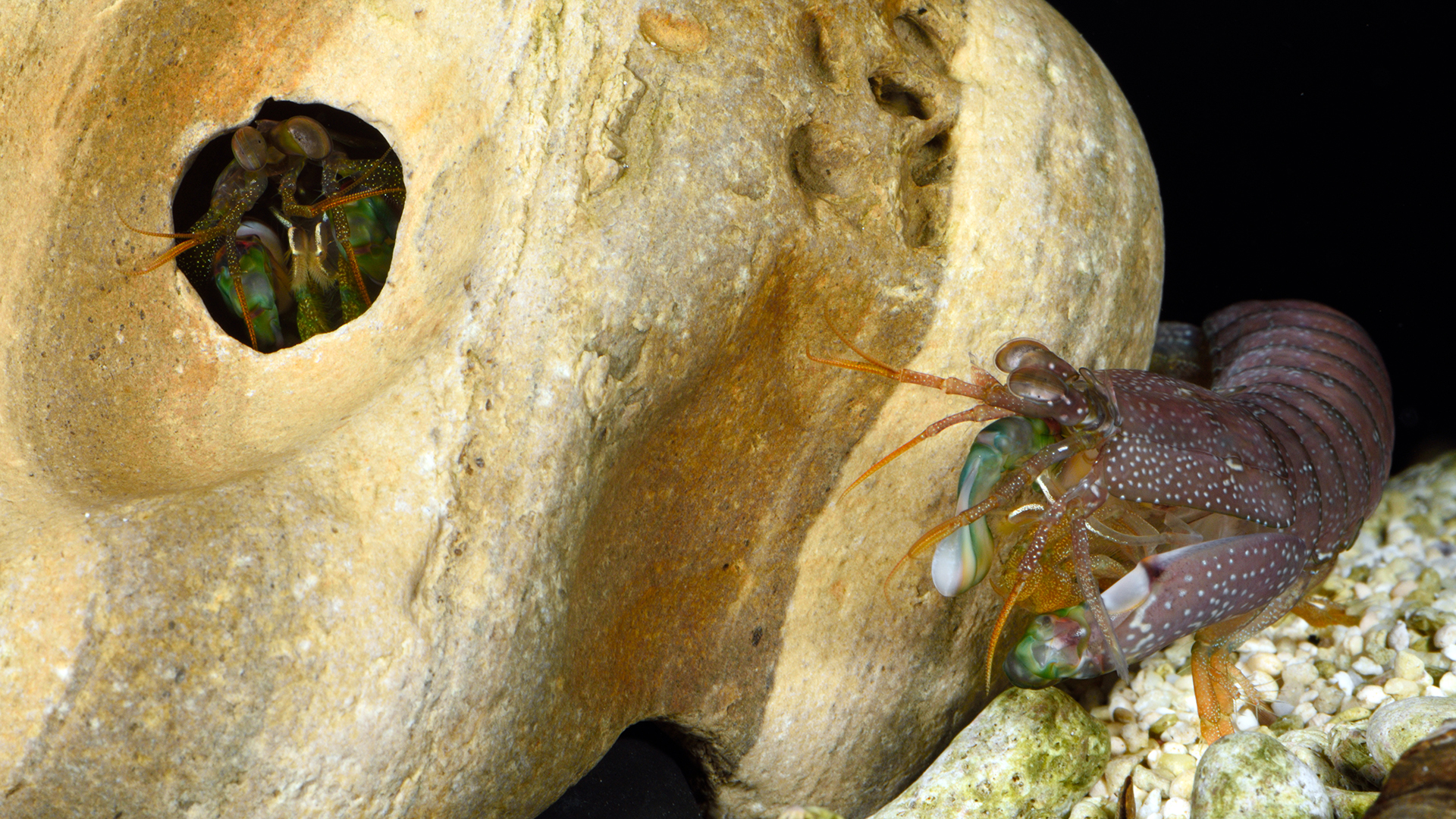Mantis shrimp punch down, pick on smaller rivals to steal their homes
Home-stealers fought the hardest for smaller-than-ideal dens.

A perfect home is hard to find, and some mantis shrimp called "smashers" for their clublike arm work hard to locate one that's just right. If the home already has an owner, the invader will fight fiercely to evict it.
To find out how aggressively this tiny crustacean will fight to throw out a previous owner of a coral burrow, researchers created "arenas" in laboratory aquariums and staged battles between mantis shrimp, over ownership of a desirable mock burrow.
Though mantis shrimp typically prefer burrows that are bigger than their bodies, leaving them room to grow, that wasn't always the case in the experiments. In the staged battles, the combatants fought hardest to win homes that were slightly smaller than ideal, perhaps because the invaders recognized that smaller burrows contained punier rivals that would be easier to defeat, the scientists wrote in a new study.
Related: Smash! Super-stabby mantis shrimp shows off in video
Despite their common name, mantis shrimp aren't shrimp; rather, they are stomatopods, a related crustacean order. For the study, the scientists collected the mantis shrimp Neogonodactylus bredini, which live in coral reefs in the southern Caribbean Sea and measure up to 2.4 inches (60 millimeters) in length, according to the Smithsonian Tropical Research Institute.
Mantis shrimp "punches" are known for their speed, accelerating at 50 mph (80 km/h) to deliver blows that can smash snail shells and crack aquarium glass. N. bredini males and females both compete for ownership of reef-rubble burrows in seagrass beds, and they deliver "potentially damaging, high-force strikes during these contests," the researchers reported.
The scientists randomly paired up male and female mantis shrimp, acclimating them separately to burrows in a range of sizes. Then, one shrimp was presented with a plastic burrow with a single opening, where it could make itself at home. Next, the scientists introduced a second shrimp to the tank, observing the interloper to see if it would attack the burrow's occupant (competitions were stopped if either of the mantis shrimp were in danger of suffering serious injury or death, according to the study).
Get the world’s most fascinating discoveries delivered straight to your inbox.
When mantis shrimp had their choice of unoccupied burrows, they typically picked options that included some growing room. But when the crustaceans had to fight for an already-occupied burrow, they fought harder and were more successful if the burrows were smaller than the ideal size, the researchers found.
Burrow residents definitely had a home-turf advantage — the invaders won just 31% of their fights. If the burrows were much too big or much too small for the invaders, they fared even worse, winning only 13% of the battles.
But when a burrow was only slightly smaller than was ideal for the invader's body size, the intruder mantis shrimp won 67% of the time. It's possible that the interlopers assessed the size of the smaller burrows and recognized that the shrimp inside would also be smaller — and easier to beat in a fight.
"We know that animals can assess a variety of factors, including the size of the opponent and the value of the prize, when deciding whether to fight and how hard to fight," said lead study author Patrick Green, a postdoctoral fellow with the Human Frontier Science Program at the Centre for Ecology and Conservation at the University of Exeter in Cornwall, England.
"In this case, as a smaller burrow is probably occupied by a smaller opponent, it seems mantis shrimps will compromise on the size of the home if it means an easier fight," Green said in a statement. "It might be assumed that animals fight hardest for the biggest assets, but this study is an example of maximum effort being reserved for something that's 'just right,'" Green said.
They published their findings online Oct. 28 in the journal Animal Behavior.
Originally published on Live Science.

Mindy Weisberger is a science journalist and author of "Rise of the Zombie Bugs: The Surprising Science of Parasitic Mind-Control" (Hopkins Press). She formerly edited for Scholastic and was a channel editor and senior writer for Live Science. She has reported on general science, covering climate change, paleontology, biology and space. Mindy studied film at Columbia University; prior to LS, she produced, wrote and directed media for the American Museum of Natural History in NYC. Her videos about dinosaurs, astrophysics, biodiversity and evolution appear in museums and science centers worldwide, earning awards such as the CINE Golden Eagle and the Communicator Award of Excellence. Her writing has also appeared in Scientific American, The Washington Post, How It Works Magazine and CNN.



